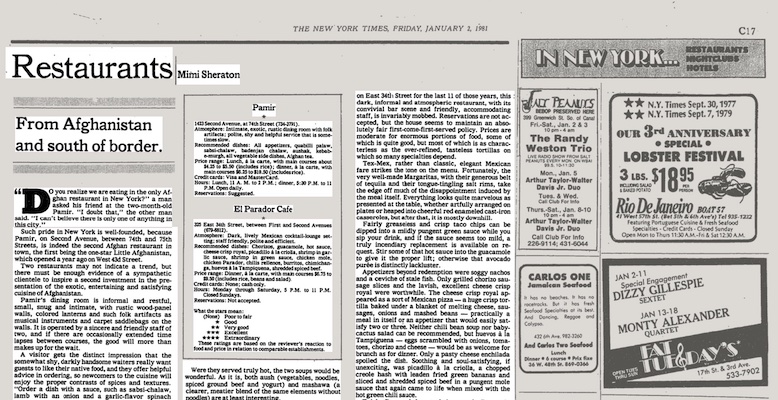Introduction
About a week ago, we were saddened to learn that Mimi Sheraton had died at the age of 97. She wasn’t a personal friend or even a casual acquaintance, but we had been taking her advice since we started The Cook and The Writer. Mimi was the author of “1,000 Foods To Eat Before You Die* , which we adopted as our Guidebook.

Mimi was also the author of 15 other books. These included cookbooks, like the mischievously titled “The Seducer’s Cookbook”* (1963), several other cookbooks, like “The New York Times Jewish Cookbook”*(2003), and a memoir, “Eating My Words: An Appetite for Life”*(2006).
But she was probably best known as the New York Times restaurant critic from 1976 to 1983, the first woman to review restaurants for The Times. After that, she went on to write for Time, Condé Nast Traveler, Harper’s Bazaar, Vogue, The Daily Beast, and, occasionally, The New York Times.
Now, to be honest, we didn’t know much about her, beyond the biographical notes in “1,000 Foods”. But after reading her obituary, we wanted to know more about her and we wanted to read some of her restaurant reviews. The more we read, the more fascinated we became.
Mimi was an innovator, an explorer, an excellent cook, and a writer with a delightful sense of humor and a razor-sharp wit. She traveled the world, tasted the food, and wrote about it in clear, evocative prose. Ten years ago she said she had eaten 21,170 restaurant meals in 49 countries since 1953. Hers might be the archetype of a life well-lived.
Here’s some of what we learned.
A Brief Biography
Miriam “Mimi” Solomon was born in Brooklyn, New York on February 10, 1926. Her father, Joseph, was a produce wholesaler who apparently hated vegetables. Her mother, Beatrice, was an excellent cook. She had dreams that her daughter would grow up and marry “the nice doctor from Scarsdale” and was critical of many of Mimi’s life choices.
Mimi attended New York University, where she majored in marketing and minored in journalism. After graduating from college in 1947, she worked writing about home furnishings for an advertising agency, then for Good Housekeeping and Seventeen magazine.
She honed her skills as a restaurant critic during stints at Cue magazine, The Village Voice, and New York magazine. In 1975 she joined The New York Times as a reporter and became their food critic in 1976.
Mimi was married twice, first to William Sheraton (1945 – divorced 1954) and then to Richard Falcone (1955 until his death in 2014). She had one son, Marc Falcone.
Mimi’s goal: Straight service
Food critics are often characterized in television and the movies as haughty and vindictive, expecting Michelin-class service at every meal, and striking fear in the hearts of restaurant owners and chefs. From all accounts we’ve seen, Mimi Sheraton didn’t fit that caricature. If there was a mold for food critics, she probably broke it.
For starters, she approached her work with a focus on informing her readers, not speaking down to them. In a 2019 interview she said
I made the restaurant critique what I would want to read if I were gonna decide, do I want to go to this place? I made it a very, very straight service. It had some humor, it had little cuts, it had digs…Every one is what I want to know – I mean, a little bit about the décor, a hint of, for a woman, what she might wear, and then the service – and you know I went [to each place I reviewed] many times.
Doing those “straight service” reviews meant following, or often exceeding, the guidelines for restaurant reviews established at The Times in the early 1960’s. Reviewers were expected to visit a restaurant multiple times. The guidelines suggested three visits, but Mimi would often dine in a restaurant six or eight times.
They were to remain anonymous, not calling attention to themselves. Over a long career, this can be tricky, even in a large city like New York. Mimi went to elaborate lengths to hide her identity. She made reservations using false names. She wore disguises, including a variety of wigs and colored glasses. Usually, she put the wig on in the cab on the way to the restaurant, so no one in her office would know what she looked like.
Hiding her identity was key to making an accurate assessment of a restaurant. In her New York Times obituary, Robert McFadden quoted Mimi from her memoir “Eating My Words: An Appetite for Life”.
The longer I reviewed restaurants, the more I became convinced that the unknown customer has a completely different experience from either a valued patron or a recognized food critic. For all practical purposes, they might as well be in different restaurants.”
Mimi’s work ethic emerged at an early age. Pete Wells, the current New York Times restaurant critic, wrote about it
Whether she was critiquing restaurants or rating pastries, she was disciplined about her methodology. She had been like that more or less since elementary school, when she and her friends went to Coney Island and rated the hot dogs at Nathan’s and Feltman’s on five characteristics, from appearance to aftertaste. To eliminate variables, all dogs were assessed with and without buns and mustard.
That methodical approach carried through her professional life. Stories are told about how she once bought over 100 corned beef and pastrami sandwiches in one day so she could study sandwich building techniques for an article. In another legendary story, she spent 11 months tasting every item sold in Bloomingdale’s food department – 1,196 in total – for a review in New York Magazine.

In Her Own Words
Writing about food is incredibly difficult. Try it: After a meal today, write a review – without using the words “delicious”, “appetizing”, or “flavorful”. What did it taste like? How did the food look? Was the service prompt and efficient? (Warning: If you were eating at home, please be careful if you criticize the cook!)
Now read it out loud.
Now stop laughing or blushing or whatever you do when you’re embarrassed.
It ain’t easy. But like any artist in prime form or athlete at the top of her game, Mimi made it look easy and effortless. Here are some examples.
A green fig
In a 2013 article for Smithsonian Magazine, Mimi wrote about her “10 Most Memorable Meals”. Number 2 on the list was tasting “a green fig plucked from a tree in an Italian garden”.
Until early one September morning long ago, the only figs I knew—and liked a lot—were dried: golden-brown, sticky and chewy with a burnished sweetness spiked with the intriguing crackle of tiny pinpoint seeds. But on the fateful morning in the Marche town of Senigallia beside the Adriatic, I tasted a small, plump jade green fig plucked from a tree in a garden. Sparkling with dew, the sun-warmed, suede-like skin yielded to a night-chilled, honeyed center—sheer ecstasy in a fruit that bore little resemblance to the dried version. I have had many delectable fresh green figs since but none that compared with the original, whether eaten out-of-hand, or split open on a plate and dabbed with a swirl of crème fraîche or a rivulet of heavy sweet cream.
Two one-star restaurants
Mimi’s weekly review columns usually featured two restaurants. In a 1981 review, Mimi gave both restaurants 1 star (Good) out of 4 and called out the things that disappointed her. But she also found ways to give some praise, too.

The first restaurant she reviewed was Pamir. At the time it was only the second Afghan restaurant in New York City. It had been open for two months when she visited. (This was the minimum time required by the NYT for reviewing a new restaurant.) She sounded hopeful as she began her review, mentioning “the exotic, entertaining, and satisfying cuisine of Afghanistan”. She took pains to complement the staff, mentioning “the sincere and friendly staff of two” who offered suggestions on what dishes to try, and noted that “if there are occasionally extended time lapses between courses, the good will more than makes up for the wait.”
Mimi described each course, providing enough detail that someone unfamiliar with Afghan food might come away with an understanding of which items they might want to try and which ones they should avoid.
The most interesting appetizers are variations on the turnover theme – bulanee gandana, crisp pancakes stuffed with scallions and topped with yogurt; bulanee kachalou, filled with potatoes, ground beef and spices, and sambosa goushti, crisp-fried pastry half-moons, plumped with ground beef and mashed chick peas to be served with a cool-hot mint sauce.
Were they served truly hot, the two soups would be wonderful.
Both desserts are skippable. Baghlawa proved dense and leathery, and firnee, a rosewater custard, was watery and cloyingly perfumed.
Having delivered praise and critique – both muted – she concluded that “a comfortable and diverting meal can be had at Pamir for moderate prices“.
She sharpened her pencil, and her tongue, for her comments about the second restaurant, El Parador Cafe.
It is virtually impossible to approach the subject of Mexican food without noting how poorly it is represented in New York and for reasons that are impossible to fathom…El Parador Cafe stands as evidence of how minimal a performance New Yorkers are willing to settle for in this particular cuisine.
Fairly greaseless and crisp taco chips can be dipped into a mildly pungent green sauce while you sip your drink, and if the sauce seems too mild, a truly incendiary replacement is available on request. Stir some of that hot sauce into the guacamole to give it the proper lift; otherwise that avocado puree is distinctly lackluster.
Appetizers beyond redemption were soggy nachos and a ceviche of stale fish… Neither chili bean soup nor baby-cactus salad can be recommended, but huevos a la Tampiguena – eggs scrambled with onions, tomatoes, chorizo and cheese – would be as welcome for brunch as for dinner. Only a pasty cheese enchilada spoiled the dish.
Fortunately, the very well-made Margaritas, with their generous belt of tequila and their tongue-tingling salt rims, take the edge off much of the disappointment induced by the meal itself. Everything looks quite marvelous as presented at the table, whether artfully arranged on plates or heaped into cheerful red enameled cast-iron casseroles, but after that, it is mostly downhill.
Wait, not the reindeer?!
Mimi’s sense of humor showed through in a 2011 article about Scandinavian food for the New York Times. She had been a fan of Scandinavian food since her first trip to Denmark nearly 60 years earlier. In the present day, she noted, it was now called “Nordic” cuisine, a name that had “a nice exotic ring, summoning visions of Greenlanders and Laplanders fishing through ice, simmering up blubber confits and salt-curing chunks of Donner and Blitzen”.
Just order the duck
In a 1980 review in the New York Times, Mimi compared two NYC restaurants that specialized in Peking duck. She gave both restaurants two stars (Very Good), noting that they would have gotten three stars (Excellent) except for their “stubborn refusal to put the proper amount of spicy seasoning in dishes traditionally requiring them”.
And she would know. Another of her 10 Most Memorable Meals was having Peking duck in Beijing, China. She described the preparation of the duck in mouth-watering detail:
Many great dishes are named for their creators, but oddly, no one is honored for Peking duck, perhaps the greatest culinary invention of all. Imagine what went into that dish’s development: knowing that to blow the slaughtered bird up with air and hang it for 24 hours will free the skin from the flesh as fat drips slowly out. Then to devise the savory glaze of rice vinegar, honey, plummy hoisin sauce, ginger, sesame oil and a pinch of hot chili peppers. The bird is then set vertically on a rack in the oven and brushed with sauce intermittently as the roasting proceeds. And to think of serving, most authentically, first the skin wrapped in hot thin crepes seasoned with hoisin with brushes of scallions and cucumber slivers to be followed by the meat and finally a heady soup of cabbage simmered with the bones of duck carcass. (Less traditionally and less ethereally, skin and meat are sometimes wrapped up together.)
Then she ended with a short cultural history lesson.
Having had Peking duck often, I was newly beguiled several years ago at the Da Dong Beijing Roast Duck Restaurant in Beijing, where women at the table were served the first course of crisped skin with small dishes of coarse, diamond-bright crystal sugar to be sprinkled on. I was told that a long-ago Chinese empress considered spices too strong for delicate feminine palates and thought sugar more appropriate. Certainly it delighted this feminine palate as the crackling sweet sugar mollified the underlying oiliness of the skin.
Conclusion
Eating at restaurants seven nights a week and sampling the entire menu had a predictable effect – Mimi got fat. After she left The Times, she lost 60 pounds.
In a world where anybody with an opinion (and you know what those are like) can share their half-formed thought on TripAdvisor or Yelp!, thoughtful writing about food can seem hard to find. But it’s out there, and those who practice the craft and we who read it owe Mimi Sheraton our thanks. She raised the bar. Let’s raise a glass to her.
Until next time / Até a próxima vez
Mary and Mike
The Cook and The Writer
Who is your favorite restaurant critic? Send us your recommendation with a note in the comments below or via the Contact Us form.
* This link is direct to Amazon.com. At the time of this writing (April, 2023), we receive no affiliate payment if you buy a copy. If that changes in the future, we’ll let you know.


Hi Mike and Mary –
Mimi Sheraton changed my life, and I am so grateful to her. Thank you for your beautiful tribute to her.
I had already read an entry in 1000 FTE by the time I read your blog on Saturday morning. It’s one of the books I read every morning, along with 1000 Places to See Before You Die and a few others. I love beginning each day with an adventure or two – new places to go, new foods to eat.
I noted on Google Keep that morning: Ghivetch (Bulgarian vegetable soup – can add beef) / 1000 FTE – p. 384
So enraptured I was by this recipe that I went searching for a place to try it out. Sadly, the Bucharest restaurants in Chicago and New York City are permanently closed , but I will find it one day. Thanks to Mimi Sheraton, I now know Ghivetch reigns supreme among the world’s vegetable soups, and I cannot wait to try it. (Since she included the recipe, I do have the option of making it at home. 🥰)
I love that her life’s work means as much to you as it does to me.
Xo,
Nan
Hi Mike and Mary….’am not much of a food critic, but to me dining “in” or “out” is more of a social occasion with friends, or more recently, it’s a good way to get to know new neighbors in the senior retirement center (aka “old folks home”) where I recently moved (to). (Ok, Mr. Writer, do I add “to” or not, as my fifth grade teacher scolded me for doing? (“to which I recently moved” sounds a bit awkward to me.)
First impressions are games I play…it’s fun discovering whether or not I’ve make a big mistake or was “right on”. On seeing Mimi Sheraton’s picture THAT SPEAKS A THOUSAND WORDS. my thoughts were, “if she were my new neighbor, that’s a person I’d like to get to know better, so I’ll invite her to dine with me tonight”. After reading your blog, I was probably “right on”…..and to me it probably wouldn’t matter that tonight’s menu is: Creamy Tomato Bisque (right out of Campbell’s): Eggplant Parmeson (just passable): Baked Beans. (same ol’):
Butternut Squash (over-cooked). (How’s that plate for color?). Oh, yes, I see that Roasted Brussel Sprouts is listed, but that’s normally little green balls of mush.
(Tonight I think I’ll fix my favorite: “Fresh Asparagus and Creamed Eggs sprinkled with the yolk, on Rye Toast”). Mmmm!
Joy Cross
(Moral of my story…be careful of the marketing promise “Fine Dining” in luxurious Senior Retirement Homes).
Oh, maaaannnn! I’m not done with my morning coffee yet and I’m already thinking about where we might find some marvelous Peking duck (or even decent Mexican) here in Lisboa! Let’s get together and have a review writing contest!!
Até breve!
David